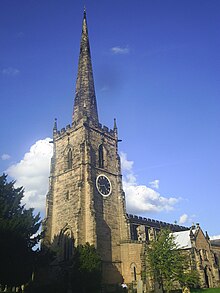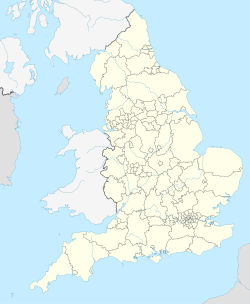St Wystan's Church, Repton
| St. Wystan's Church, Repton | |
|---|---|
 Repton Church | |
| 52°50′26″N 01°33′11″W / 52.84056°N 1.55306°W | |
| OS grid reference | SK 303 272 |
| Country | United Kingdom |
| Denomination | Church of England |
| Churchmanship | Broad Church |
| Website | reptonchurch.org.uk |
| History | |
| Status | Parish church |
| Founded | Repton Abbey established c.600AD |
| Founder(s) | Saint David (traditionally) |
| Dedication | St Wystan |
| Relics held | St Wystan (moved by King Cnut to Evesham Abbey) |
| Architecture | |
| Functional status | Active |
| Heritage designation | Grade I listed |
| Designated | 19 January 1967 |
| Architect(s) | Arthur Blomfield (restoration) |
| Architectural type | Church |
| Style | Anglo-Saxon, Gothic |
| Specifications | |
| Spire height | 212 feet (65 m) |
| Clergy | |
| Vicar(s) | Revd. Peter Paine |
St. Wystan's Church is an Anglican parish church in Repton, Derbyshire that is famous for its Anglo-Saxon crypt which is the burial place of two Mercian Kings.[1] The church is recorded in the National Heritage List for England as a designated Grade I listed building, and is dedicated to the Anglo-Saxon Saint Wystan (or Wigstan), who was formerly buried within the church's crypt.[2]
Description
For early history, please see: Repton Abbey
The Anglo-Saxon abbey church was cruciform and may have had a tower over its central crossing.[3] The nave of the current church has Medieval Gothic north and south aisles that were rebuilt in the 13th century and widened early in the 14th century.[4] The west tower and recessed spire were added in 1340.[4] The top of the spire is 212 feet (65 m) above ground level.[4] In the 15th century the nave clerestory with its timber roof and the two-storey porch were built and the tower windows were altered.[4] Monuments inside the church include an alabaster effigy of a knight from about 1400 and monuments to members of the Thacker family from 1563 and 1710.[4] The tower has a ring of eight bells, the oldest of which was cast at Leicester in about 1500.[5]
The church was restored between 1885 and 1886 by Arthur Blomfield.[6]
Crypt and royal burials

The Crypt was constructed in the early 8th century; it was built over a spring and is thought to have originally been a baptistery.[1]
It was converted into a mausoleum for King Æthelbald of Mercia, during his lifetime. King Wiglaf and his grandson Saint Wigstan (after whom the later church is named), were also buried in the crypt.[1]
It is thought that the royal bodies were first buried in the ground to decompose before their bones were interred in the crypt.[1]
Following Saint Wigstan's burial, the crypt became a place of pilgrimage.[1] However, following the Danish (Viking) invasion, St Wigstan's body was removed and taken with the fleeing monks.[7] It was later returned but King Cnut had St Wigstan's remains removed again in the 10th century; having them reburied at Evesham Abbey.[7]
Nikolaus Pevsner described the Anglo-Saxon parts of St. Wystan's parish church as "one of the most precious survivals of Anglo-Saxon architecture in England".[3] In addition to the crypt they include the chancel, the northeast and southeast parts of the crossing and part of the north transept.[3] The crypt is a square chamber with a roof of three rows of three domical vaults supported by two pilasters on each wall and four free-standing pillars at the four corners of the central vault.
Royal burials
- King Æthelbald of Mercia - died 757.
- King Wiglaf of Mercia - died 839.
- Prince/Saint Wigstan - died 849. (remains moved by King Cnut to Evesham Abbey)
Monuments
- South transept: George Waklin 1617 and Ellen Waklin 1614, John Macauley 1840. Thomas Whitehead 1645 (erected in 1802)
- South aisle: Gilbert Thacker 1563.
- North aisle: Rev Joseph James 1856. William Bagshaw Stevens 1800. Francis Thacker 1710.
Churchyard
The churchyard contains the war graves of 17 Commonwealth service personnel (mostly Royal Air Force of World War II.[8] Also buried there are the ashes of C.B. Fry, whose tombstone, dedicated in 2008, describes him as "Cricketer, Scholar, Athlete, Author - The Ultimate All Rounder."[citation needed]
Organ
The church contains a 2 manual 23-stop tracker action pipe organ by Peter Collins dating from 1998. The specification can be found at the National Pipe Organ Register
Organists
- Thomas Dalby ca.1847[9]
- Herbert Stevens 1865[10] - ????[11]
- A.E. Rogers 1887[12] - ????
- Mr. Hodgkinson ca.1903[13]
- William James ca. 1909[14]
- Edgar Foster ???? - 1916
- Miss Partridge 1916–1918
- Edgar Foster 1918 - ????
- Cyril Woodward - c1950s
- Andrew Patterson - 1983-87
- Terence W Bennett - 1987 -
Parish status
The church is in a joint parish with:
See also
References
- ^ a b c d e Repton Church: The Crypt http://www.reptonchurch.org.uk/Crypt.htm
- ^ Historic England, "Church of St Wystan, Repton (1334560)", National Heritage List for England, retrieved 16 August 2012
{{cite web}}: CS1 maint: postscript (link) - ^ a b c Pevsner & Williamson, 1978, page 303
- ^ a b c d e Pevsner & Williamson, 1978, page 305
- ^ Dawson, George (1 July 2009). "Repton S Wystan". Dove's Guide for Church Bell Ringers. Retrieved 29 September 2011.
- ^ Derby Mercury - Wednesday 28 July 1886
- ^ a b Repton Church: Time Line http://www.reptonchurch.org.uk/index.htm
- ^ REPTON (ST. WYSTAN) CHURCHYARD, Commonwealth War Graves Commission, retrieved 2 March 2013
- ^ Royal Cornwall Gazette - Thursday 24 November 1898
- ^ Derby Mercury - Wednesday 15 March 1865
- ^ Derby Mercury - Wednesday 31 March 1886
- ^ Derby Mercury - Wednesday 23 February 1887
- ^ Derby Daily Telegraph - Wednesday 16 September 1903
- ^ Derby Daily Telegraph - Wednesday 4 August 1909

